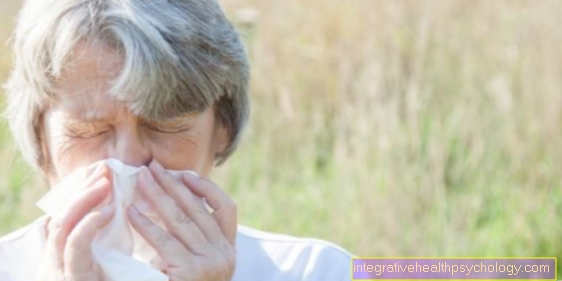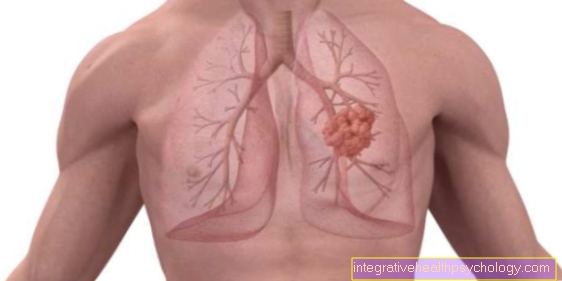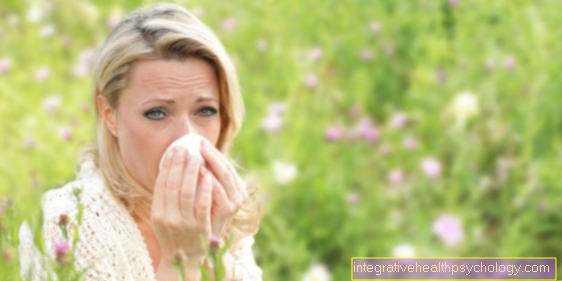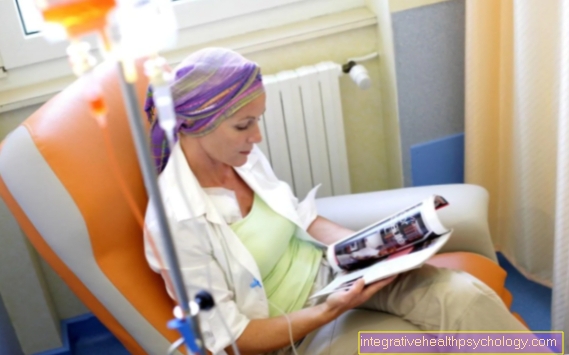Eczema in the ear
Introduction - what is eczema on the ear?
Ear eczema is an inflammation of the skin of the auricle. Eczema manifests itself as reddish spots, which are usually associated with severe itching. Eczema is the largest percentage of skin diseases. They make up 30 to 40%. The term is a collective term for inflammatory, mostly itchy, non-contagious skin diseases. If the eczema affects not only the auricle, but also the external auditory canal, one speaks of otitis externa diffusa. From a symptomatic point of view, eczema on the ear is very similar to an outer ear infection (External otitis).

Symptoms of eczema in the ear
Typical changes that occur with eczema in the ear are reddening of the auricle and other skin changes on the ears. Often these are blistering. Often there is severe itching, which is the most uncomfortable perception for the patient. Some patients also experience pain in the ear and a burning sensation at the same time. Sometimes it can also manifest itself with a fever. If this is the case, a doctor should definitely be consulted for treatment. Depending on the course, the skin is damp and weeping or dry and flaky. The weeping form often results in painful swelling of the external auditory canal with an accompanying greasy flow of secretion. Often, eczema is also associated with an increased production activity of the sebum glands. One then speaks of seborrheic eczema (see also Infant seborrheic eczema), which can be weeping or dry.
Read more on the topic: Auricular pain
Course of eczema
Eczema is divided into acute and chronic eczema according to its course. Acute eczema is characterized by severe itching, accompanied by reddening and blistering. The eczema often oozes and then crusts over easily. Chronic eczema, on the other hand, tends to be dry and the skin is flaky and calloused. Chronic eczema is also accompanied by itching. Due to the chronic course, the skin thickens, becomes cracked and rough.
In some cases, the inflammation can spread to the ear canal or from the ear canal to the auricle.
Figure eczema in the ear

Ear eczema (allergic-inflammatory
related skin irritation)
- Reddish spots
- Blistering
- Scaly and horny
- Eczema in the external ear canal -
Otitis externa diffusa - cartilage
- Auricle -
Auricula - Earlobe -
Lobulus auriculae - External ear canal -
Meatus acousticus externus - Greasy flow of secretion
- Swelling of the
external ear canal
Causes:
A - contact allergies -
Metallic substances,
Food -
Nickel allergy (earrings, necklace) -
exogenous eczema
B - types of cosmetics -
Skin creams, powders, lotions
Neurodermatitis
(Skin disease)
C - genetic predisposition -
atopic eczema
(Neurodermatitis) -
endogenous eczema
D - rose (erysipelas)
Alternative treatment:
E - antibiotics,
Cortisone preparations
F - natural remedies -
Medicinal plants (aloe vera,
Arnica, birch, etc.,
essential oils (jasmine,
Chamomile, lavender),
Schüssler salts (8 + 12)
You can find an overview of all Dr-Gumpert images at: medical illustrations
Causes of Eczema in the Ear
A distinction is made between exogenous eczema that has arisen through external influences, so-called contact eczema, and endogenous eczema that has arisen through internal influences from the body. When it comes to contact eczema, a distinction is again made between allergic contact eczemas that are caused, for example, by certain foods or metals, and non-allergic contact eczemas that are caused by chemicals such as cleaning agents or cosmetics that are aggressive to the skin. Most often, allergies to earrings, cosmetics, soaps or shampoos are responsible for eczema on the ear. If it is endogenous eczema, these patients are genetically predisposed to it. Ten percent of the population have this genetic predisposition. The most common type of endogenous eczema is atopic eczema, better known as neurodermatitis. If one of the parents has atopic dermatitis, there is a 30% chance that the children will also develop the disease. If both parents are affected, the probability for the child to fall ill is 60%.
Based on the causes, one can see that eczema of the auricle is not infectious, i.e. not caused by bacteria, viruses or fungi. Since the skin is damaged by the inflammation in eczema and often cracks as a result, despite the non-infectious origin, bacteria or other pathogens can easily penetrate the damaged skin areas. In some cases they can even reach the cartilage and lead to complications (see Complications).
Complications
If the inflamed area becomes colonized with bacteria, it can lead to perichondritis. The causative bacteria are mostly staphylococci. With perichondritis the inflammation spreads to the cartilageso that cartilage-free areas such as the earlobe are not affected. If this infection is not treated, the cartilage is destroyed and the auricle is permanently deformed. In addition to perichondritis, a complication of ear eczema can also result in a sore rose (technically speaking Erysipelas) come. A wound rose is usually through Streptococci (bacteria) triggered. The bacteria spread to the subcutaneous tissue of the auricle and its surroundings. Since the cartilage is not affected in this case, as is the case with perichondritis, the inflammation can also spread to the ear lobes and the adjacent facial area.
Diagnosis
Eczema can usually be diagnosed by a doctor through a visual diagnosis. If the external auditory canal is also affected, the doctor to be examined will perform an otoscope (Otoscopy) by. Often the eardrum cannot be seen due to swelling of the ear canal and obstruction due to waste products during an otoscope. If contact dermatitis is suspected in connection with an allergic reaction, dermatological allergy diagnostics can also be used. If there is a bacterial complication, a smear is usually taken to identify the pathogen so that a pathogen-specific antibiotic can be used for treatment
Eczema on the earlobe
Earring wearers in particular should think of an allergic reaction if they have eczema on the earlobe. Above all, allergic reactions to jewelry made of nickel are caused. In some cases, creams or shampoos can also cause allergic reactions, whereby the reaction usually affects the entire ear. The most important measure is to remove the allergen - for example the earring. Since the earlobe can swell up due to the allergy, it should be cooled.
Furthermore, the treatment of the allergic reaction consists of cortisone creams or antihistamines. Eczema on the earlobe can also occur with neurodermatitis. Here, however, the rash is often on the lower edge of the earlobe. This is where atopic dermatitis often tears the skin. These cracks in the skin can be particularly painful. Neurodermatitis is also often treated with cortisone creams in the case of acute inflammation. Whether atopic dermatitis or an allergic reaction, eczema on the earlobe is usually accompanied by severe itching in addition to reddening.
Find out more about the topic here: Inflamed earlobe and torn earlobe
Eczema in the auricle
Eczema in the auricle that merges into the external auditory canal is also known as otitis externa. This inflammation occurs due to an infection with various bacteria or fungi, or due to an allergic reaction.
An allergic reaction can be triggered, for example, by soaps, shampoos, hairspray or even hearing aids. The eczema usually begins with itching and, if the external auditory canal is involved, it can be accompanied by ear pain, for example when chewing.
If the eczema occurs as part of an allergic reaction or neurodermatitis, it usually results in red, dry and flaky skin in the auricle and in the ear canal. If the eczema is caused by a bacterial infection, ear drops that contain antibiotics should be used.
Antifungal (anti-fungal) ear drops are given for fungal infections. Allergic reactions or neurodermatitis are treated with cortisone creams or antihistamines.
Read more about the topic: Inflammation of the auricle
Itching of the ear
Eczema is often accompanied by severe itching. The rash on the ear and the resulting itching can occur with neurodermatitis, seborrheic eczema, shingles of the ear, bacterial infections or, particularly often, with a contact allergy. The itching is caused by the inflammation in the skin. Sometimes this is so strong that the skin is scratched bloody. This prevents or slows down the healing process and can make it easier for germs to enter the wounds. Hence, it is important to treat the itchiness.
Pain in the ear
Pain rarely occurs with eczema. Above all, scratched skin can cause pain, especially when touched or when one lies on the affected ear. Swelling caused by allergic reactions, for example of the earlobe, can also cause severe pain when touched. Shingles of the ear (zoster oticus) can cause severe pain in both the ear and the auricle.
Therapy for eczema in the ear
If an ear is affected by eczema, it should be given special care as part of basic care. This mainly serves to prevent secondary infections caused by bacteria, fungi or viruses, which can better implant themselves in the damaged skin. In this context, products that additionally dry out the skin should be avoided, such as alkaline soaps, alcoholic lotions, baths above 35 ° C and intensive sunbathing.
If the cause of the eczema is an allergic reaction in the sense of contact eczema, the allergen should be eliminated immediately. For the causal treatment of eczema, active ingredient-free ointments or oil baths are suitable.
If it is an open, weeping eczema, moist or greasy dressings are used to prevent dehydration and also have a cooling effect. For a greasy bandage, a greasy ointment is applied to the affected area on the ear. A moist bandage is placed over it, which is then connected again with a dry bandage. The bandage should be left in place for three to five hours.
Of course, preparations with active ingredients are also used, such as urea preparations. Urea has a beneficial effect on the corneal layer and relieves itching. It also has slight antibacterial properties. If the basic therapeutic measures do not work, cortisone preparations can be used. Usually 0.5 percent hydrocortisone cream is used. Cortisone is used primarily for its anti-inflammatory properties. Cortisone therapy is often used as part of interval therapy - this is carried out in alternation with basic care. If there is an additional bacterial colonization in connection with the eczema, antibiotics are usually used. Perichondritis is treated with a double therapy, consisting of an antibiotic adapted to the pathogen and a corticosteroid. In the case of a wound rose, the treating doctor injects a high-dose antibiotic against streptococci. Ointments containing cortisone and ointments containing antibitoka can also be used in the form of bandages. Herbal remedies are also often used.
Homeopathy and natural remedies
Many natural remedies can be used to treat eczema. Medicinal plants such as aloe vera, arnica, birch, nettle, St. John's wort, chamomile, burdock, evening primrose, marigold and yarrow are used. Essential oils are also used. These include: jasmine, chamomile, lavender, lemon balm, tea tree and thyme. Essential oils can be used in the form of a fragrance lamp, rubs in, ointments or steam baths. They should be avoided in babies and toddlers. In addition, some home remedies have proven themselves in the treatment of eczema, such as honey, propolis, apple cider vinegar and zinc ointment or zinc tablets. Schüssler salts can also be used. With eczema you can use the Schüssler salts number 8 (Sodium chloratum), Number 12 (Calcium Sulfuricum) and number 20 (Kalium aluminum sulfuricum). Schüssler salts are used three to six times a day with one or two tablets each time.
Home remedies
There are many different home remedies that can be used for eczema. Since not every home remedy has the same effect on every person affected, it is necessary to test individually which home remedy has an individual effect. Against eczema, means can be used that have anti-inflammatory and anti-itch effects. Aloe Vera moisturizes and has anti-inflammatory effects. Quark or yoghurt have anti-inflammatory effects and their cooling effect relieves itching. Since yoghurt and quark have to be washed off after they have dried out, they should only be applied to the ear for external use.
Black tea can also be boiled and cooled and placed on the affected eczema as a bag, which accelerates healing. Diluted apple cider vinegar can help with the symptoms of ear eczema. To do this, the vinegar should be diluted with water (ratio of water to vinegar 9: 1). The mixture should be applied to the ear several times a day. Evening primrose oil and marigold ointment can also help relieve symptoms of eczema. If a fever occurs, a doctor must be consulted.
Read more about the topic: Quark wrap
Eczema in the baby
Infant seborrheic eczema is common in babies, too Button gneiss called. Often, seborrheic infant eczema occurs within the first few months of life, but this usually disappears on its own after a few weeks. In some cases, however, it can also last for several months. Infant seborrheic eczema does not itch and is therefore not perceived as uncomfortable for the child. Overall, it is a harmless rash that is usually not weeping. One suspected theory for the development of such eczema is hormones that the baby came into contact with during pregnancy. These hormones stimulate the sebum glands to produce a secretion, which then leads to crust formation. A few months after the birth, the effects of these hormones wear off and the rash goes away on its own. Another theory is that babies of parents with allergies are more likely to develop seborrheic dermatitis than children of non-allergy parents.
Seborrheic eczema is often confused with the so-called cradle cap. This is the slang term for atopic eczema, better known as neurodermatitis in infancy. A change in the skin occurs, which is similar to milk that is burnt and crusted in the pot, hence the name cradle cap. Itchy reddening of the skin occurs, accompanied by the formation of blisters and, later, crust formation. These skin changes can spread to the body and persist for months to around two years. However, a transition to the chronic inflammatory variant of atopic eczema is also possible. The existing itching is an important differentiator to seborrheic infant eczema. Therapeutically, ointments and herbal preparations are mainly used for small children. In particular, cortisone-containing ointments should be avoided in babies.
Read more on this topic at: Eczema in the baby
Recommendation from the editorial team!
Here you can find out everything about the topics:
- Neurodermatitis
- Atopic dermatitis
- Eczema on the face
- Eczema on the eye
- Eczema on the eyelid
- Eczema ear canal





.jpg)























